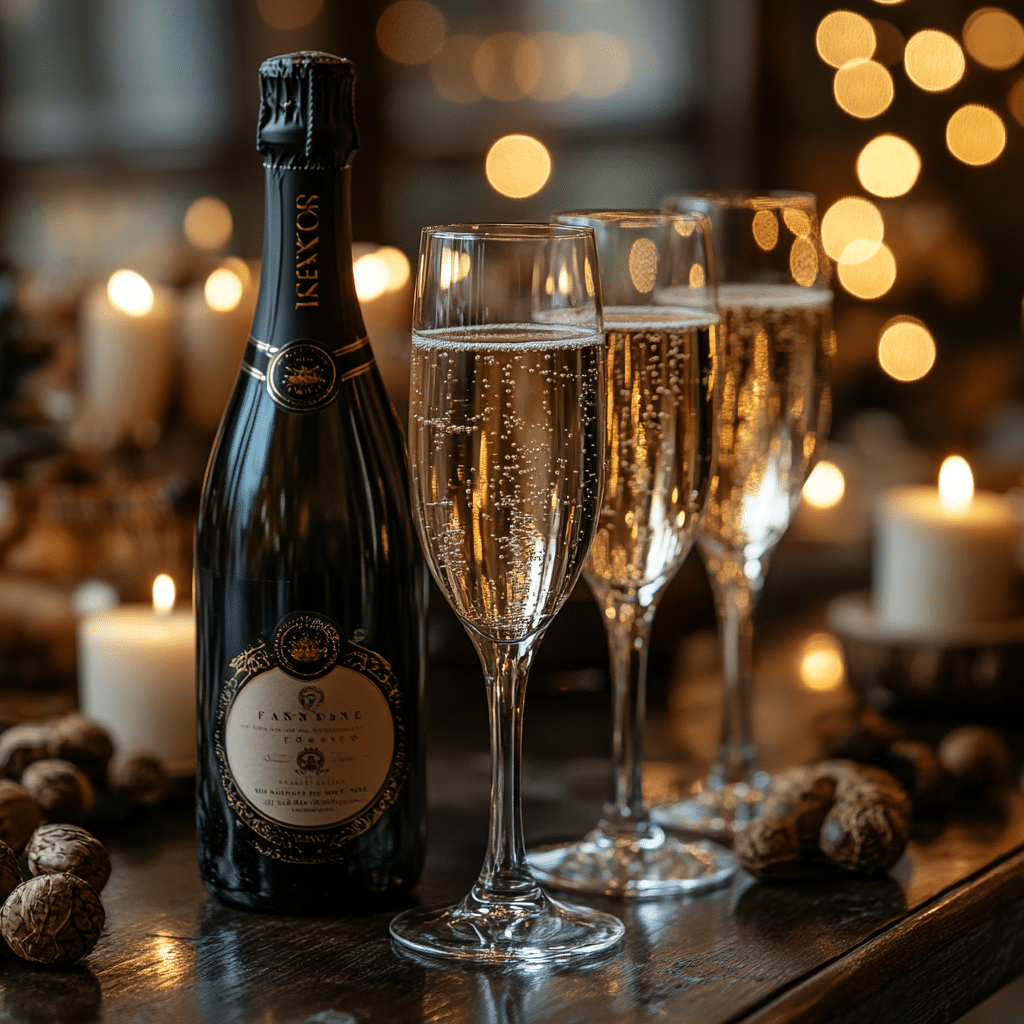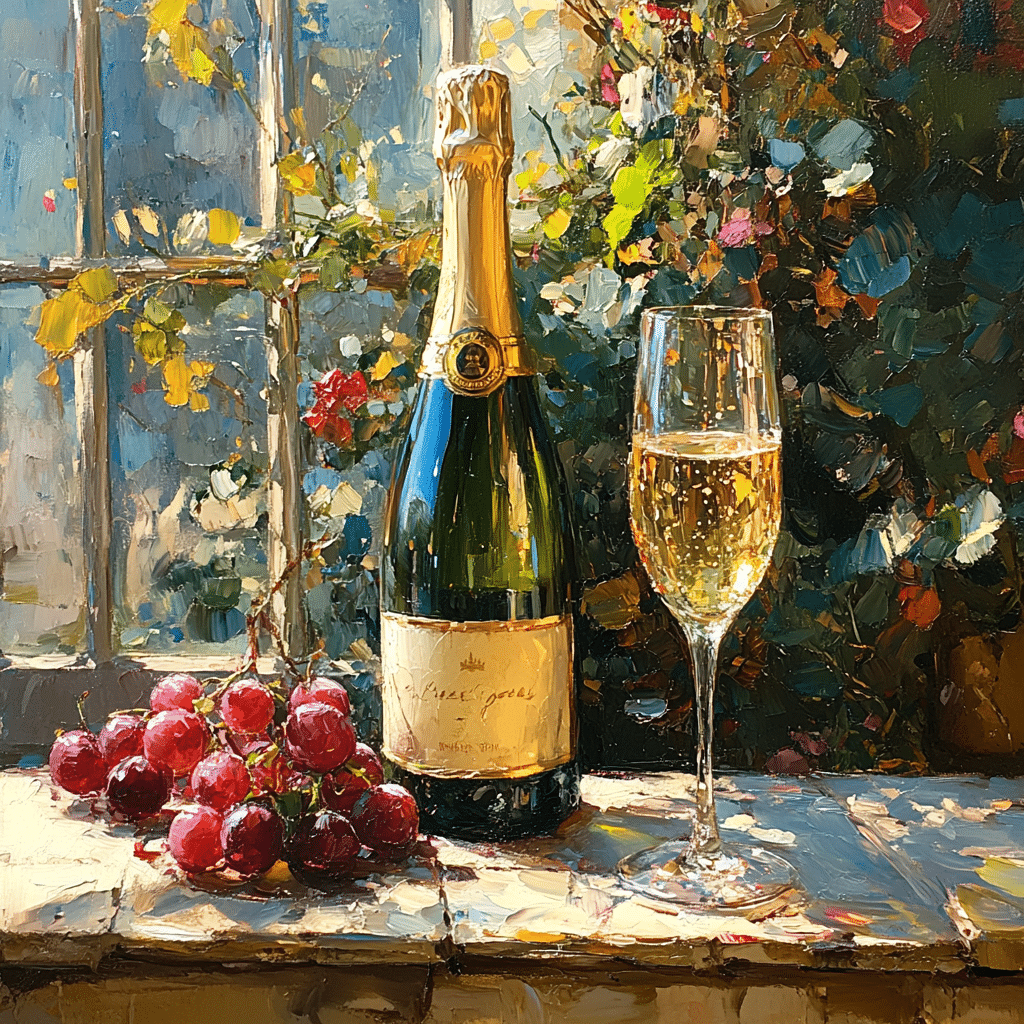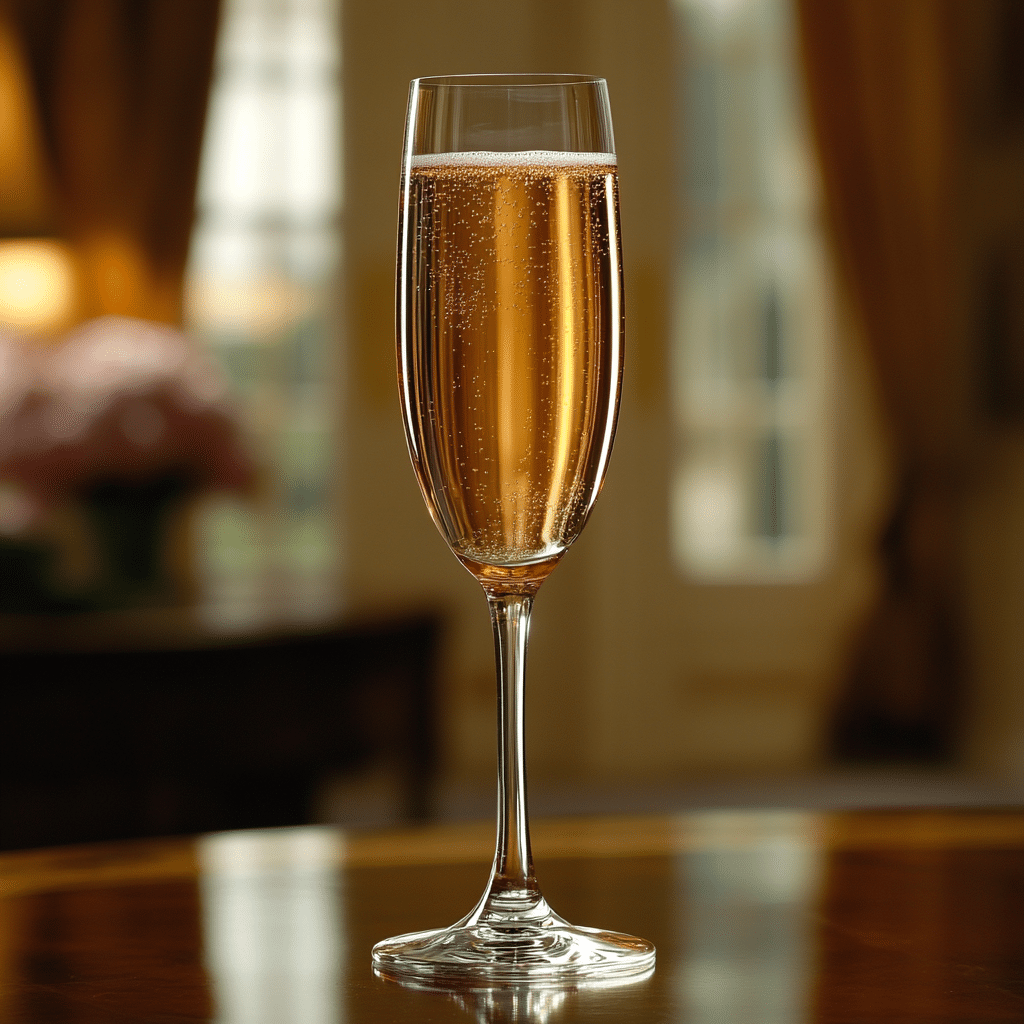French champagne is more than just a drink; it’s a symbol of celebration, elegance, and artistry. Originating from the famous Champagne region of France, French champagne holds a prestigious place in culinary history and culture. With its strict production regulations established by the Comité Champagne, every bottle of champagne is crafted from grapes grown in specific geographical boundaries. The unique terroir—characterized by its chalky soils and a climate perfect for grape cultivation—plays a vital role in shaping the distinct flavors of this beloved bubbly.
Champagne’s history dates back to the 17th century, with pivotal advancements in production techniques marking its evolution. Dom Pérignon, a Benedictine monk, is frequently credited as the father of champagne. He revolutionized the champagne-making process and established the concept of blending different grape varieties to create a more balanced taste. Today, champagne is a global symbol of luxury, but its origins remain grounded in the traditions and innovations of this historical region.
In essence, French champagne is a wine of place, meaning its characteristics cannot be truly replicated elsewhere. While sparkling wines, like Prosecco, have gained popularity, genuine French champagne remains unmatched due to its regulated production and distinct heritage. Let’s take a closer look at the best brands that personify the elegance of French champagne.
Top 7 Best French Champagne Brands to Experience
When one thinks of French champagne, specific renowned brands immediately come to mind. Here’s a detailed exploration of seven exceptional producers that epitomize the finest of this sparkling wine:
With a legacy dating back to 1743, Moët & Chandon is a household name that signifies celebration and luxury. Its flagship, Moët Impérial, is famous for its fresh and fruity character, offering an exquisite sipping experience that has made it a favorite at celebrations worldwide.
Known for its iconic yellow label, Veuve Clicquot boasts a rich history of producing high-quality champagne. Its Vintage Brut, celebrated for its complex aroma of ripe fruits and brioche, sets a benchmark in the champagne world and reflects the producer’s commitment to excellence. The brand’s influence extended well beyond France, exporting champagne globally to countries like the United States and Asia.
Renowned for its signature Cristal champagne, Louis Roederer has a reputation for impeccable craftsmanship. With a blend of fine Pinot Noir and Chardonnay grapes, Cristal delivers an opulent, refined experience, making it the choice of royalty and celebrities alike.
Krug stands out for its philosophy that values individuality and craftsmanship. The Krug Grande Cuvée is its crowning jewel, praised for its depth and complexity derived from a unique blend of multiple vintages—a true art form in the world of French champagne.
With an emphasis on Chardonnay, Taittinger’s flagship Brut Réserve showcases elegant floral notes and fruity flavors. This champagne is renowned for its soft, creamy texture, making it a delightful companion at any gathering.
Bollinger is celebrated for its rich and full-bodied champagnes, focusing on Pinot Noir to create depth. Its Special Cuvée is particularly noted for its powerful flavor profile, appealing to those who savor intense tastes.
With a history dating back to 1785, Piper-Heidsieck’s innovative spirit shines through its offerings. The Cuvée Brut provides a delightful balance between freshness and richness, demonstrating its versatility and making it perfect for pairing with various culinary delights.

The Craft of Making French Champagne: Key Techniques and Styles
Delving into the craft of making French champagne reveals a blend of tradition and innovation. The traditional méthode champenoise stands as the cornerstone of champagne production, involving a second fermentation process within the bottle that produces its celebrated effervescence. The craftsmanship extends to vineyard management and careful grape selection, ensuring each element contributes to the final profile of the champagne.
Champagne is categorized based on its sugar content into six distinct styles, including Doux (the sweetest), Demi Sec, Dry, Extra Dry, Brut, Extra Brut, and Brut Nature—the latter being entirely dry. This range caters to diverse palates and occasions, making French champagne a versatile choice for any celebratory moment.
Production has also embraced modern techniques, with temperature-controlled fermentation and precision viticulture becoming standard. By adapting to climate and environmental changes, producers maintain the quality and integrity of their wines, ensuring that French champagne retains its prestigious reputation while embracing the future.
| Feature | Details |
|---|---|
| Origin | Must come from the Champagne region of France. |
| Key Champagne Houses | Veuve Clicquot, Nicolas Feuillatte, Canard-Duchêne |
| Export Markets | Europe, United States, Asia, and more |
| Top Selling Brand | Nicolas Feuillatte (best-selling in France, third globally) |
| Champagne Classification | 1. Doux (sweetest) 2. Demi Sec 3. Dry 4. Extra Dry 5. Brut 6. Extra Brut 7. Brut Nature |
| Bottle Sizes | Commonly 75cl, available in larger formats (Magnum, Jeroboam, etc.) |
| Production Philosophy | Champagne viewed as a “wine of place” that cannot be replicated elsewhere |
| Historical Note | Veuve Clicquot was significant in exporting champagne internationally, enhancing brand recognition |
| Location of Notable Houses | Canard-Duchêne located 20 minutes from Reims city center, in the heart of the vineyard |
| Typical Price Range | Prices can vary widely; entry-level wines starting around €30, prestigious cuvées may exceed €200+ |
| Benefits | Unique terroir contributes to quality and flavor; high social status associated with consumption |
Pairing French Champagne with Culinary Delights
Contrary to popular belief, French champagne pairs beautifully with an array of cuisines beyond just celebrations. For instance, Moët & Chandon complements seafood dishes splendidly, enhancing the delicate flavors of dishes like oysters or grilled fish. The bright acidity of champagne cuts through the richness of butter and cream sauces, making it a fantastic partner for creamy pasta dishes.
Veuve Clicquot, with its bold flavors, pairs wonderfully with rich cheeses such as Brie or aged Gouda, creating an extraordinary gastronomic experience. Additional pairings include Taittinger with light appetizers or light desserts like fruit tarts, showcasing the versatility of French champagne in various culinary contexts.
Understanding the intricacies of food and champagne pairing not only elevates your dining experience but enhances appreciation for the art of crafting French champagne. By choosing the right dish to complement your favorite bubbly, you create memorable moments filled with flavor and elegance.

The Global Influence of French Champagne: Beyond Borders
Although firmly rooted in France, the influence of French champagne extends far and wide. International markets have warmly embraced this iconic beverage, highlighted by global festivals celebrating champagne culture. Events like the Champagne Harvest Festival draw attention from enthusiasts worldwide, breaking down barriers and creating a shared appreciation for this sparkling gem.
Social media has also played a vital role in the burgeoning popularity of French champagne, with influencers and celebrities often showcasing it in their lifestyle posts. The sparkling beverage has become synonymous with celebrations and luxury, painting a picture of glamour that resonates with consumers today. This heightened visibility helps connect traditions with modernity, elevating the allure of French champagne.
In addition, global economic dynamics have created new markets for French champagne producers, particularly in Asia. Countries like China and Japan have developed a burgeoning taste for luxury goods, leading to a significant increase in champagne consumption, ensuring its place in a wider culture.
Why French Champagne Remains a Timeless Icon
Despite the surge of sparkling wines from various regions, French champagne continues to hold the throne as the standard of luxury. The meticulous attention to detail in its production—rooted in centuries-old traditions—paves the way for its enduring appeal. Brands have adapted to changes without compromising their legacy, embracing sustainable practices that address climate change and evolving consumer preferences.
Moreover, the mystique surrounding champagne enhances its allure. There’s something inherently magical about a bottle of French champagne: from its production to the moments it celebrates. As new generations discover and appreciate this sparkling wine, the legacy of French champagne remains intact.
However, challenges loom. The changing climate poses threats to traditional growing techniques and grape cultivation regions. Producers must find new methods to secure their vineyards while keeping the quality that defines French champagne. Yet, the industry remains resilient, committed to preserving the artistry that elevates champagne to a timeless icon.
In every toast and celebration, French champagne resonates as more than just a beverage; it encapsulates artistry, tradition, and life’s finest moments. As we explore its rich history, diverse brands, and global influence, it becomes evident that French champagne not only celebrates joy but does so with an elegance and sophistication that remains unmatched.
Whether you’re enjoying a glass during a festive occasion or savoring it with a delightful meal, embracing French champagne promises an unforgettable experience that continues to enrich our lives.
French Champagne: Fun Trivia and Fascinating Facts
The Charm Behind the Bubbles
Did you know that the process of making french champagne is as much an art as it is a science? It all begins with a secondary fermentation that takes place in the bottle itself. This intricate method not only gives champagne its signature bubbles but also contributes to its exceptional flavor. While many know about the sparkling drink, the way that it go through meaning in terms of flavor development remains a charming mystery. Different regional grapes, from Chardonnay to Pinot Noir, play a vital role, making each bottle a delightful surprise. Interestingly, the terroir, or the local environment, can significantly impact the taste.
Now, about those bubbles! Have you ever wondered why champagne always seems to look so festive? Scientists have discovered that the bubbles in french champagne are created through tiny nucleation sites in the bottle, often caused by imperfections on the glass. When champagne is poured, carbon dioxide forms bubbles around those imperfections, creating the delightful effervescence we love. So, the next time you’re sipping a glass, consider how these little elements influence your drink’s enjoyment! Also, fun fact: the champagne market value has seen quite a rise in recent years, which speaks to its growing popularity among wine enthusiasts and casual drinkers alike.
A Toast to History
The history of french champagne is rich and steeped in tradition. The region of Champagne, where this iconic drink originates, has over three hundred years of winemaking history, dating back to the 17th century. If you look at the historical evolution of production techniques, you might be surprised to find that the famed method was perfected by Monks seeking divine inspiration in every bottle. Their dedication and ingenuity help make champagne a symbol of celebration that we still raise glasses to today. Speaking of celebrations, did you know that the iconic found television show Characters made appearances in champagne-themed episodes? Those pop culture connections further emphasize how champagne has crept into our everyday celebrations.
As we sip on our bubbly, it’s worthwhile to note that french champagne commonly boasts a perfect balance of sweetness and acidity. This balance allows it to pair beautifully with a variety of foods, from savory to sweet. And while we’re enjoying that sumptuous taste, let’s not forget to appreciate the environmental benefits of champagne production. Many vineyards are becoming increasingly eco-conscious, implementing sustainable practices that can help preserve the beautiful landscape of Champagne. Balancing modern trends with tradition genuinely showcases a vibrant future for the sparkling beverage we all love! Now, if you’re curious about how much you’re willing to invest in a quality bottle, you might start by checking out What Is The interest rate on home Loans today; after all, a delightful bottle can be as worth it!
So there you have it—some delightful nuggets about french champagne! Whether you’re toasting to love, friendship, or a stunning sunset, remember that each bottle carries a piece of history, culture, and artistry. Cheers!

What Champagne is most popular in France?
Nicolas Feuillatte is the most popular champagne brand in France, even though it ranks third globally.
Is Veuve a French Champagne?
Yes, Veuve Clicquot is indeed a French Champagne, renowned for its rich history and significant presence in the world of sparkling wines.
What’s the difference between Champagne and Prosecco?
The main difference between Champagne and Prosecco is that Champagne must come from the Champagne region in France, while Prosecco is primarily produced in Italy’s Veneto region.
What French winery is known for Champagne?
Champagne Canard-Duchêne, located about 20 minutes from Reims, is one of the respected houses known for its quality champagne and deep ties to the local region.
What are the top 5 champagnes?
The top five champagnes can vary by preference, but popular brands often include Moët & Chandon, Veuve Clicquot, Dom Pérignon, Laurent-Perrier, and Bollinger.
What is the most luxurious Champagne brand?
The most luxurious Champagne brand is often considered to be Dom Pérignon, known for its vintage offerings and prestigious reputation.
Why is Veuve Clicquot so expensive?
Veuve Clicquot tends to be expensive due to its rich heritage, high-quality grapes, and meticulous production methods that ensure consistency and luxury.
What makes Veuve Clicquot so special?
What’s special about Veuve Clicquot is its blend of tradition and innovation, being one of the first houses to produce a consistent, high-quality champagne that embodies elegance and a unique taste.
How to drink Veuve Clicquot?
To enjoy Veuve Clicquot, serve it chilled in a flute glass to enhance its bubbles and flavors, making sure to savor the experience.
Is Prosecco just cheap Champagne?
Prosecco’s often seen as more budget-friendly compared to Champagne, but calling it “cheap” doesn’t do justice to its distinctive taste and charm.
Is cava better than Prosecco?
Cava is a sparkling wine from Spain that some people might prefer over Prosecco, but it really comes down to personal taste as they each have their own unique profiles.
What Champagne is best for mimosas?
For mimosas, a good choice is a dry Champagne like Brut or a fruity Prosecco, as they mix well with juice without being overly sweet.
What is the most famous Champagne in France?
Veuve Clicquot is one of the most famous champagnes in France, known for its quality and iconic yellow label.
Why is French Champagne so expensive?
French Champagne can be pricey due to the limited production areas, the quality of its grapes, and the traditional methods used in its production.
What are the three wines in Champagne?
The three main types of grapes used in Champagne are Chardonnay, Pinot Noir, and Pinot Meunier, each contributing its unique characteristics to the final product.
What is the royal family’s favorite Champagne?
The British royal family has a history of favoring Bollinger Champagne for its special occasions and celebrations.
How do I choose French Champagne?
When choosing French Champagne, consider your personal taste, the occasion, and whether you prefer something sweeter or drier, along with exploring different brands.
Is Moet or Mumm better?
Whether Moët or Mumm is better really depends on personal preference, as both offer distinct flavors and styles that can appeal to different palates.
What is the most popular style of Champagne?
The most popular style of Champagne is Brut, appreciated for its balance of sweetness and dryness, making it a favorite for many occasions.



